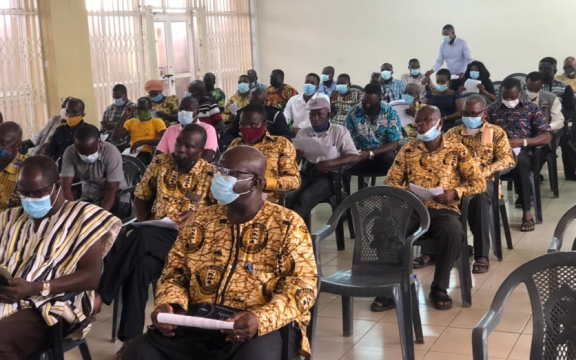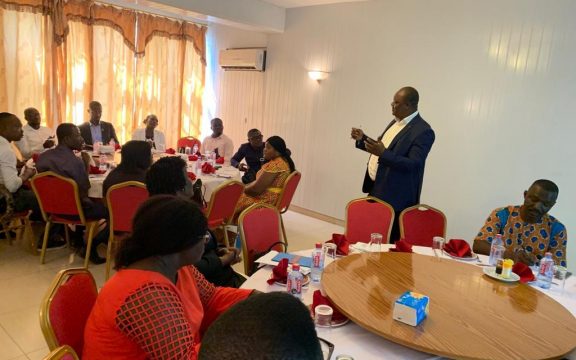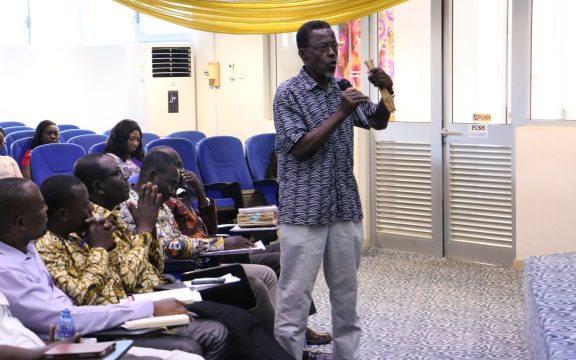 The UN projects that Africa’s population will more than triple from the current 1.3 billion to 4.3 billion people by 2100. At that number, it will be home to more than 8-in-10 people in the world just like Asia.
The UN projects that Africa’s population will more than triple from the current 1.3 billion to 4.3 billion people by 2100. At that number, it will be home to more than 8-in-10 people in the world just like Asia.
As the population continues to grow, the demand for food, especially high-value crops and livestock products, will grow too. A 2021 Alliance for Green Evolution in Africa (AGRA) report referenced data that reflected that the growing demand for food in Africa “is usually met through international imports” than through intra-African imports compared to Europe, which has a higher intra-regional food trade. In fact, statistics from 2016 to 2018 showed that Africa imported about 85 per cent of its food from outside the continent. In 2019, Sub-Saharan African countries were reported to have imported $1.1 billion worth of cereals from other Sub-Saharan Africa countries compared to $12.8 billion from rest of the world.
The Food and Agriculture Organization (FAO) data projects that the global food import bill is on course to reach a new record high of US$1.8 trillion this year, $49 billion of which will reflect higher prices. This means that poor and vulnerable people especially in the group of Net Food-Importing Developing Countries of which most African countries are members will pay more but receive less food.
 Some studies have while not disregarding the contribution of political, environmental, and other internal factors, recognized that Africa’s food security challenges is traceable to when it developed trading relations with Europe. That relationship led to developing an ‘economically unhealthy’ taste for all things foreign including food. Since then, there has been a gradual but consistent move over several decades towards increasing food supplies per person; by increasing imports.
Some studies have while not disregarding the contribution of political, environmental, and other internal factors, recognized that Africa’s food security challenges is traceable to when it developed trading relations with Europe. That relationship led to developing an ‘economically unhealthy’ taste for all things foreign including food. Since then, there has been a gradual but consistent move over several decades towards increasing food supplies per person; by increasing imports.
The continent has as a result become food import dependent.
It is important to recognize the vital relationship between taste and economic development. What people consume have significant consequences for their economic circumstances. The taste for foreign goods and the perception that foreign goods are superior to locally made goods started when the first Europeans landed on the shores of Africa. An engineered campaign to glamorize western goods has been consciously sustained over several decades through various forms of media i.e. movies, advertisements (audio and video), etc. These campaigns have succeeded in making local and indigenous goods seem inferior and even uncivilized sometimes. So, for instance it is acceptable for a rich or middle-class Caucasian not to know about or eat any African food but in the same breadth, a rich or middle-class African who does not know or eat western foods and eats only local and indigenous foods will be looked down on or regarded as unexposed and even uncivilized.
Many African children today want pizza and burgers for their birthdays and other special days because such foods have been glamorized through movies and other forms of media to be food for ‘cool’ and ‘modern’ people. This has affected the level of consumption of local and indigenous African foods and led to increased imports of food and related items.
Many restaurant chains and franchises have sprung up all across the continent serving pizza and other flour-based foods western foods which are in high demand due to all the factors discussed. These foods are made from wheat-based flour which are imported with billions of dollars. For the 2020/2021 trade year alone, African Wheat imports amounted to 54.8 million metric tons, about 26.6 million metric tons of the amount were destined for Sub-Saharan Africa. Three countries Russia, France, and Ukraine alone were the main suppliers of wheat to the continent, the value of their exports being about USD 7.2 Billion.
 The USD 7.2 billion is foreign exchange outflow for only one item for which we have developed tastes. But there are available and cheaper alternatives to the wheat-based flour on the continent: cassava and corn for which most of the continent’s people are yet to develop a taste for. There are a few exceptions in Central Africa “where cassava-based flour is part of the basic ingredients for their cuisine”. However, in West Africa where many countries including Ghana, Nigeria, etc. are among the top producers of cassava, the consumption of cassava-based flour compared to wheat-flour remains very low.
The USD 7.2 billion is foreign exchange outflow for only one item for which we have developed tastes. But there are available and cheaper alternatives to the wheat-based flour on the continent: cassava and corn for which most of the continent’s people are yet to develop a taste for. There are a few exceptions in Central Africa “where cassava-based flour is part of the basic ingredients for their cuisine”. However, in West Africa where many countries including Ghana, Nigeria, etc. are among the top producers of cassava, the consumption of cassava-based flour compared to wheat-flour remains very low.
Data from Statista shows that the top 5 exporters of wheat between 2014/2015 and 2021/2022 are the European Union, Russia, Australia, Ukraine and United States respectively.
Taste for foreign goods and poor perceptions have led to low consumption of indigenous foods. The consequence of which is the continent’s food insecurity.
Indigenous African vegetables have the potential to sustainably address malnutrition, which is a growing problem in sub-Saharan Africa, but their consumption is limited due to poor perceptions and lack of awareness of their nutritional benefits. This perception problem continues to lead to massive foreign exchange outflows (in tens of billions of dollars), export of badly needed jobs, heightens food inflation, a weakened agricultural sector and ultimately greater food insecurity.
Furthermore, rising food prices as a result of the Covid-related impacts (huge public debts), effects of the Russia-Ukraine war (rising energy and fertilizers prices, shipping costs/supply chain challenges, lost supply of cereals etc.) are having devastating macroeconomic impacts on many African countries. This has steeply pushed up inflation while significantly shrinking household incomes putting households that were already struggling as a result of the economic-related challenges of the covid pandemic in more precarious positions.
WHAT IS TO BE DONE?
The solution to overcoming the continent’s food sufficiency still lies within the continent. It does through
collective self-reliance – regional food trade which has been an open secret. Achieving food sufficiency will help to reach African Union’s Agenda 2063 Goal 3 and United Nation’s Sustainable Development Goal (SDG) 2.
— The taste and economics campaign mechanism
The African Development Bank (AfDB) recognizes that “without intervention, net import levels will likely increase to over US$100bn by 2025”. Therefore, to reverse the net food import situation, the taste of Africans must be reengineered. The African Import Export Bank (Afrexim) and the AfCFTA Secretariat have a big role in changing the taste of Africans back to indigenous foods and ‘Made in Africa’ products.
The call by the President of the AfDB; Dr. Akiwumi Adesina for “young Africans to take pride in their continent and invest in its development by staying in Africa” is commendable which must be taken a step further by starting a campaign to work on the psyche of the continent’s people to perceive eating indigenous African foods, succeeding in Africa, buying Made in Africa, supporting African businesses as the ‘new cool’ and a sign of patriotism or loyalty to the motherland.
 People eat every day and with the current food crisis, food trade is the perfect starting point for reducing food insecurity and achieving deeper regional trade integration. The Afrexim must akin to the intra-Africa trade initiative, fund a massive taste and economics information campaign spearheaded by the AfCFTA Secretariat to promote African food and culture deliberately and consciously through investing in and providing funding for movies, series and animations for kids to shape their minds to be Afrocentric and influence their choices. The animations kids watch greatly shape their perspectives and who they aspire to be, what food they even want to eat and heroes they have.
People eat every day and with the current food crisis, food trade is the perfect starting point for reducing food insecurity and achieving deeper regional trade integration. The Afrexim must akin to the intra-Africa trade initiative, fund a massive taste and economics information campaign spearheaded by the AfCFTA Secretariat to promote African food and culture deliberately and consciously through investing in and providing funding for movies, series and animations for kids to shape their minds to be Afrocentric and influence their choices. The animations kids watch greatly shape their perspectives and who they aspire to be, what food they even want to eat and heroes they have.
Properly glamorizing African foods and cultures through animations to expose children to them, will make the idea of regional integration easily acceptable to them because it will be engrained in their minds. The messages to encourage patronage of indigenous foods and locally produced goods (‘Made in Africa’) must involve sponsoring songs, music videos, etc. that carry these messages in the local languages to drive the message home.
These films and animations must be sent to the very remote villages to reach children using information and video vans that would visit several communities several times in a month to show animations and movies promoting African foods and cultures and why people must trade with their neighbors and other African countries. These shows can be interspersed with exciting activities especially indigenous games from other African countries while emphasizing African values. These will both create employment and shape minds.
The campaign must be so well engineered and broken down to be able to point out the health and economic benefits of eating local and indigenous foods and buying ‘Made in Africa’. It must show the extent to which people’s daily little actions amount will amount to much and contribute to improving the fortunes of the continent and changing their own lives for the better. The campaign must glamorize the idea of ‘the African personality’ and ‘the Africa we want’ to encourage people to aspire to and work towards their attainment.
As the AfDB itself noted, regional integration efforts had not succeeded because it had not been a priority of development partners. This mindset shift campaign must be a priority for the continent especially the institutions who have the mandate to ensure the achievement of deeper regional integration and economic freedom.
The USD 1.5 billion approved by the Afdb’s board of directors at the bank’s recent AGM in Accra to support “20 million farmers produce an extra 38 million metric tons to address fears of starvation and insecurity” must also set aside some budget to fund the taste and economics campaign.
— A private radio station’s campaign to promote the consumption of indigenous foods
In Ghana, a private radio station, Citi Fm has been embarking a on campaign to get people in the capital (Accra) to eat indigenous Ghanaian foods through a campaign they call “back to your village food bazaar”. This hugely patronized by the middle class and ‘modern people’ in Ghana due to how well it is promoted.
The campaign aims to promote the consumption of local foods, support local businesses, create jobs and reduce imports. Previous editions have featured indigenous Ghana foods like Tuo Zaafi, Ampesie, Tubani, Banku and okro stew, etc. along with performances and exhibitions from local artistes.
This commendable and patriotic campaign must be celebrated. It is an example of the type of campaign that should be sponsored by Afrexim and the AfCFTA secretariat all across the continent to promote taste for local and indigenous foods to reduce food imports and its adverse economic effects.
Promoting consumption of local and indigenous foods at the highest levels
Local and indigenous foods must be served at the highest levels, including at the AU, regional economic communities and presidential levels. This will help to prop the glamor campaign to encourage people to embrace it and make it attractive to foreign tourists and visitors. Uganda’s President’s calling for his people to eat cassava and other cassava-based foods because he eats them himself is commendable leadership, something that needs to be promoted by the AfCFTA Secretariat.
In a recent contribution to the BBC’s letters from African journalists’ program, Madam Elizabeth Ohene (a former BBC journalist) wrote about how gari: a granular flour made from cassava was served at state banquets hosted by Prime Minister Kofi Abrefa Busia in Ghana in 1970. She wrote “gari really became the ultimate haute-cuisine item when Ghana’s legendary caterer, Barbara Baeta, devised a recipe for “gari foto” – gari mixed with gravy and seafood”. This act as Madam Ohene noted suddenly made gari fashionable and began to be “served at gatherings for the high and mighty.”
Again towards the 2016 elections in Ghana, then opposition leader Nana Addo Dankwa Akufo-Addo was seen in a viral photo sipping a locally manufactured fruit drink (Kalyppo) which hitherto was considered to be for children. When the issue came into the media, people began to buy the product, a move which increased the sales of the company considerably. One news report noted that some traders admitted that their sales had increased by about 40 percent within the last few weeks.
Increasing the volume and value of regional trade through the taste and economics campaign will lead to improved access to better, more affordable, and more nutritious food. This will lead to the creation of more and higher paying jobs; offering improved opportunities for Small and Medium Enterprises; and contribute to a more vibrant localized economy, reduce the massive foreign exchange outflows, improve food security and develop the continent’s agricultural sector.
Conclusion
AfCFTA is about mindset shift and reorientation as much as it is about
trade integration. Afrexim and the AfDB must invest in and do the hard things that will get the African people to develop strong tastes for and consume local and indigenous foods while being proud to do so.













